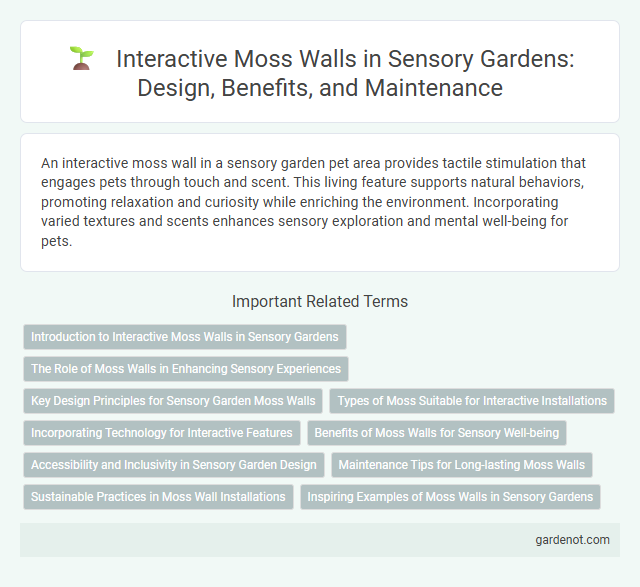An interactive moss wall in a sensory garden pet area provides tactile stimulation that engages pets through touch and scent. This living feature supports natural behaviors, promoting relaxation and curiosity while enriching the environment. Incorporating varied textures and scents enhances sensory exploration and mental well-being for pets.
Introduction to Interactive Moss Walls in Sensory Gardens
Interactive moss walls in sensory gardens provide a tactile and visual experience that enhances sensory stimulation for visitors. These walls incorporate various moss species with differing textures, colors, and moisture levels, encouraging touch and engagement while promoting relaxation and mindfulness. Integrating interactive moss walls supports biodiversity and air purification, making them a sustainable addition to therapeutic and educational garden spaces.
The Role of Moss Walls in Enhancing Sensory Experiences
Interactive moss walls significantly enhance sensory experiences by providing tactile stimulation and natural aesthetics that engage sight and touch. The soft, vibrant textures of moss create a calming environment while improving air quality through natural filtration. Incorporating moss walls in sensory gardens fosters mindfulness and emotional well-being, making them ideal for therapeutic and educational settings.
Key Design Principles for Sensory Garden Moss Walls
Interactive moss walls in sensory gardens prioritize tactile engagement and accessibility, incorporating diverse moss species to offer varying textures and colors that stimulate multiple senses. Key design principles include ensuring moisture retention through proper substrate selection, optimizing lighting conditions to sustain moss health, and integrating height variations for ease of touch by users of all ages and abilities. Strategic placement of scent-emitting plants and materials around the moss wall enhances the immersive sensory experience, promoting relaxation and cognitive stimulation.
Types of Moss Suitable for Interactive Installations
Interactive moss walls thrive with species like cushion moss (Leucobryum glaucum), known for its dense, soft texture that invites tactile engagement. Sheet moss (Hypnum cupressiforme) enhances visual appeal through its vibrant green hues and ability to cover large surfaces seamlessly. Mood moss (Dicranum scoparium) offers durability and resilience, making it ideal for installations exposed to varying humidity and touch.
Incorporating Technology for Interactive Features
Interactive moss walls integrate advanced sensors and LED technology to create dynamic, touch-responsive surfaces that engage multiple senses. These innovative installations use moisture and touch sensors to trigger visual and auditory feedback, enhancing sensory stimulation and user interaction. By combining natural elements with smart technology, interactive moss walls foster immersive experiences in sensory gardens, promoting relaxation and cognitive engagement.
Benefits of Moss Walls for Sensory Well-being
Interactive moss walls enhance sensory well-being by providing tactile engagement that reduces stress and promotes relaxation through natural textures. These walls improve indoor air quality by absorbing pollutants and regulating humidity, contributing to a healthier environment. Incorporating moss walls in sensory gardens supports mental clarity and emotional calmness, making them ideal for therapeutic and educational settings.
Accessibility and Inclusivity in Sensory Garden Design
An interactive moss wall in a sensory garden enhances accessibility by incorporating tactile elements reachable at wheelchair height, ensuring users with mobility challenges can engage fully. Utilizing diverse textures and varying moss types promotes inclusivity, catering to individuals with different sensory preferences and cognitive needs. Clear signage with braille and auditory feedback further supports visitors with visual impairments, creating an equitable sensory experience.
Maintenance Tips for Long-lasting Moss Walls
Regular misting of the interactive moss wall maintains optimal humidity, preventing dryness and ensuring vibrant green growth. Avoid direct sunlight exposure to preserve moss texture and color, while gently dusting the surface weekly removes debris without damaging delicate moss structures. Inspecting the wall monthly for pests or mold helps address issues early, extending the lifespan and sensory appeal of the moss installation.
Sustainable Practices in Moss Wall Installations
Integrating sustainable practices in interactive moss wall installations involves using locally sourced, non-toxic materials and ensuring efficient water usage to minimize environmental impact. These moss walls promote air purification and biodiversity by supporting natural microbial ecosystems. Maintenance strategies focus on eco-friendly cleaning methods and leveraging renewable energy for lighting and irrigation systems.
Inspiring Examples of Moss Walls in Sensory Gardens
Interactive moss walls in sensory gardens create immersive environments that engage touch, sight, and smell, offering therapeutic benefits and enhancing sensory stimulation. Examples like the Moss Wall at the Chicago Botanic Garden integrate natural textures and adjustable lighting to stimulate interaction and relaxation. Innovative designs use preserved moss varieties such as reindeer and sheet moss to maintain vibrant color and tactile appeal year-round, fostering connection with nature in urban spaces.
Interactive moss wall Infographic

 gardenot.com
gardenot.com